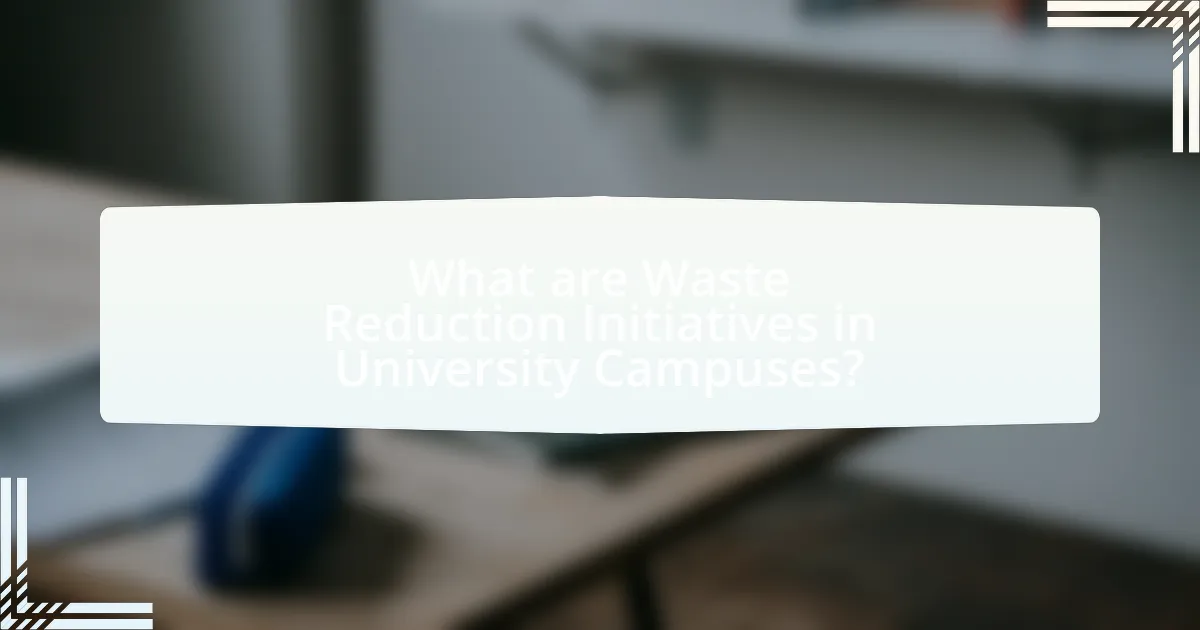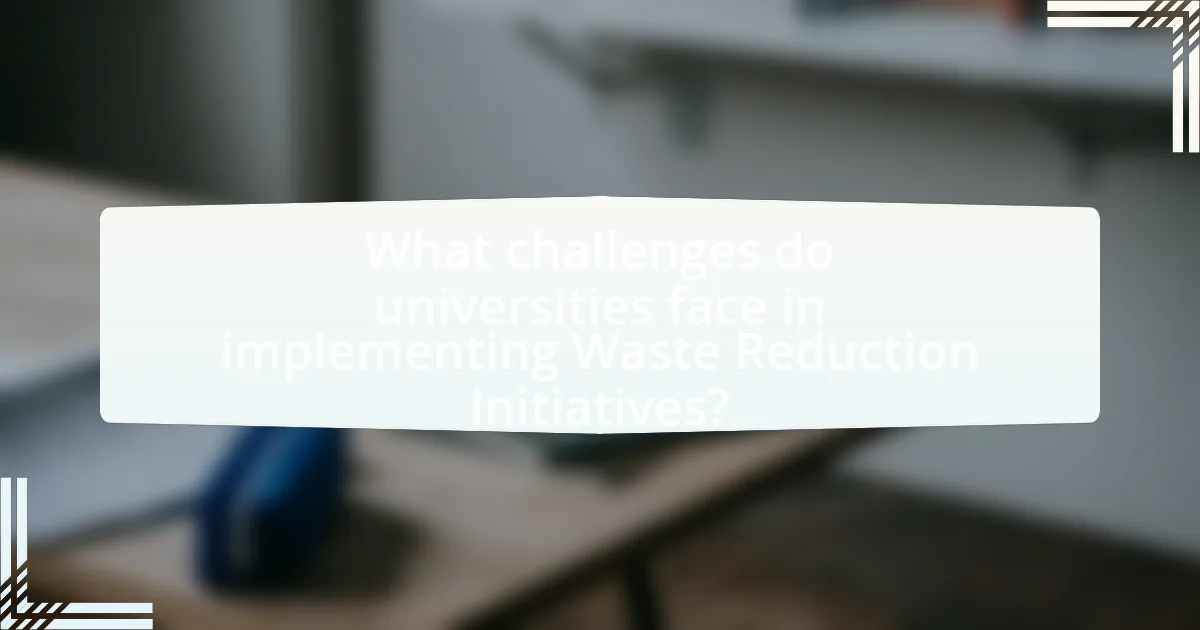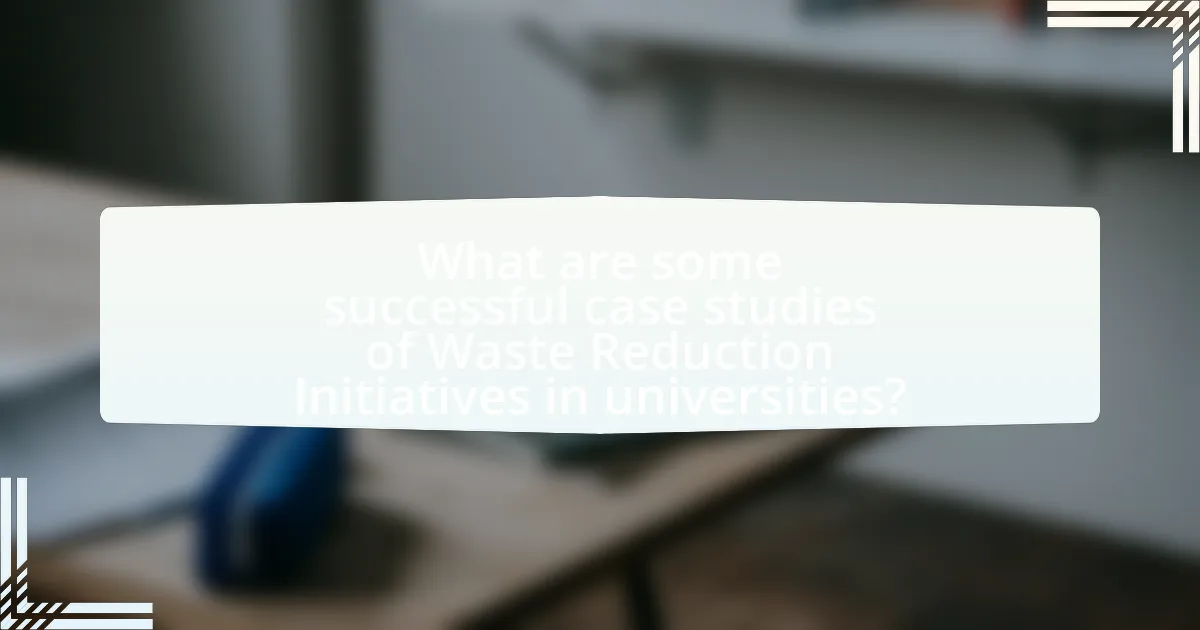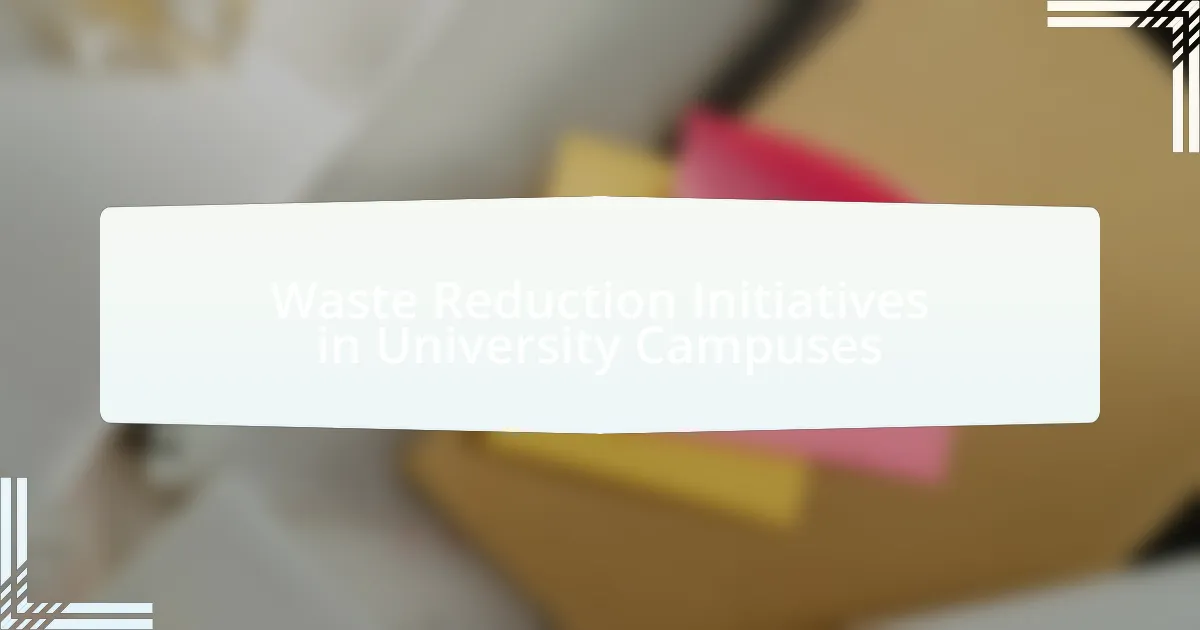Waste reduction initiatives in university campuses encompass various programs and practices designed to minimize waste generation and enhance sustainability. Key components include recycling programs, composting efforts, waste audits, and educational campaigns aimed at raising awareness about waste management. These initiatives are crucial for reducing environmental impact, fostering a culture of sustainability among students and staff, and achieving broader sustainability goals. Challenges such as limited funding, insufficient infrastructure, and lack of engagement can hinder their effectiveness, but successful case studies demonstrate that comprehensive strategies can lead to significant waste diversion and community involvement.

What are Waste Reduction Initiatives in University Campuses?
Waste reduction initiatives in university campuses are programs and practices aimed at minimizing waste generation and promoting sustainability. These initiatives often include recycling programs, composting efforts, waste audits, and educational campaigns to raise awareness about waste management. For example, the University of California system has implemented a zero waste goal, aiming to divert 90% of waste from landfills by 2020 through comprehensive recycling and composting programs. Such initiatives not only reduce the environmental impact of campuses but also engage students and staff in sustainable practices, fostering a culture of environmental responsibility.
Why are Waste Reduction Initiatives important for universities?
Waste reduction initiatives are important for universities because they significantly decrease environmental impact and promote sustainability. By implementing these initiatives, universities can reduce waste generation, which contributes to lower landfill use and decreased greenhouse gas emissions. For instance, a study by the National Recycling Coalition found that universities that adopted comprehensive waste reduction programs saw a 30% reduction in waste over five years. Additionally, these initiatives foster a culture of environmental responsibility among students and staff, encouraging sustainable practices that extend beyond campus.
What environmental impacts do universities have related to waste?
Universities significantly impact the environment through waste generation, contributing to pollution and resource depletion. They produce large amounts of waste, including food waste, plastics, and electronic waste, which can lead to increased landfill use and greenhouse gas emissions. For instance, a study by the National Recycling Coalition found that higher education institutions generate approximately 1.5 million tons of waste annually in the United States alone. This waste often contains recyclable materials that, if diverted, could reduce the environmental footprint and promote sustainability. Additionally, improper waste management practices can lead to soil and water contamination, further exacerbating environmental issues.
How do waste reduction initiatives contribute to sustainability goals?
Waste reduction initiatives significantly contribute to sustainability goals by minimizing resource consumption and reducing landfill waste. These initiatives, such as recycling programs and composting, lower greenhouse gas emissions associated with waste disposal and resource extraction. For instance, a study by the Environmental Protection Agency indicates that recycling and composting prevented the release of approximately 186 million metric tons of carbon dioxide equivalent into the air in 2013, demonstrating the positive environmental impact of waste reduction efforts. By promoting efficient resource use and fostering a culture of sustainability, these initiatives align with broader sustainability objectives, such as reducing environmental footprints and conserving natural resources.
What types of Waste Reduction Initiatives are commonly implemented?
Commonly implemented waste reduction initiatives include recycling programs, composting systems, and waste minimization strategies. Recycling programs facilitate the collection and processing of materials like paper, plastics, and metals, significantly reducing landfill contributions. Composting systems convert organic waste into nutrient-rich soil amendments, thereby diverting food scraps and yard waste from landfills. Waste minimization strategies involve practices such as reducing single-use items, promoting digital documentation, and encouraging the use of reusable containers, which collectively lower overall waste generation on university campuses. These initiatives are supported by studies indicating that effective recycling and composting can reduce waste by up to 50% in educational institutions.
What are the most effective strategies for reducing waste on campus?
The most effective strategies for reducing waste on campus include implementing comprehensive recycling programs, promoting composting initiatives, and encouraging the use of reusable materials. Comprehensive recycling programs can increase recycling rates by up to 30%, as evidenced by a study conducted by the National Recycling Coalition, which found that well-structured programs significantly enhance participation. Composting initiatives divert organic waste from landfills, with universities like the University of California reporting a 50% reduction in food waste through their composting efforts. Additionally, encouraging the use of reusable materials, such as water bottles and shopping bags, can lead to a substantial decrease in single-use plastics, as demonstrated by the University of Michigan’s initiative that reduced plastic waste by 40% after introducing a reusable container program.
How do recycling programs fit into waste reduction initiatives?
Recycling programs are integral to waste reduction initiatives as they directly decrease the volume of waste sent to landfills. By facilitating the recovery and processing of materials like paper, plastics, and metals, recycling programs help conserve natural resources and reduce environmental impact. For instance, the Environmental Protection Agency (EPA) reports that recycling and composting prevented the release of approximately 186 million metric tons of carbon dioxide equivalent into the air in 2018, highlighting the significant role of recycling in mitigating climate change. Thus, recycling programs not only support waste reduction but also contribute to broader sustainability goals on university campuses.
How do universities engage students in waste reduction efforts?
Universities engage students in waste reduction efforts through educational programs, recycling initiatives, and hands-on sustainability projects. These institutions often implement workshops and campaigns that raise awareness about waste management and environmental impact, encouraging student participation. For example, many universities have established recycling programs that involve students in sorting and managing recyclable materials, which fosters a sense of responsibility and community involvement. Additionally, universities may host competitions or challenges that incentivize students to reduce waste, such as zero-waste events or sustainability fairs, which have been shown to significantly increase student engagement and awareness regarding waste reduction practices.
What role do student organizations play in promoting waste reduction?
Student organizations play a crucial role in promoting waste reduction by implementing initiatives that raise awareness and encourage sustainable practices among their peers. These organizations often lead campaigns focused on recycling, composting, and reducing single-use plastics, which directly contribute to minimizing waste on campus. For example, a study by the National Wildlife Federation found that campuses with active student-led sustainability groups reported a 30% increase in recycling rates compared to those without such organizations. By organizing events, workshops, and educational programs, student organizations effectively engage the student body and foster a culture of environmental responsibility, thereby significantly impacting waste reduction efforts.
How can educational campaigns influence student behavior regarding waste?
Educational campaigns can significantly influence student behavior regarding waste by increasing awareness and promoting sustainable practices. These campaigns often utilize targeted messaging, workshops, and interactive activities to educate students about the environmental impact of waste and the importance of recycling and composting. Research indicates that universities implementing educational initiatives, such as the “Waste Watchers” program at the University of California, Berkeley, saw a 30% increase in recycling rates among students within one academic year. This demonstrates that well-structured educational campaigns can effectively change student attitudes and behaviors towards waste management.

What challenges do universities face in implementing Waste Reduction Initiatives?
Universities face several challenges in implementing Waste Reduction Initiatives, primarily including limited funding, lack of student and staff engagement, and insufficient infrastructure. Limited funding restricts the ability to invest in necessary resources and technologies for effective waste management. A study by the National Recycling Coalition indicates that many universities struggle to allocate budgets for sustainability programs, which hampers their waste reduction efforts. Additionally, lack of engagement from students and staff can lead to low participation rates in recycling and composting programs, as highlighted in research published by the Journal of Cleaner Production, which found that awareness and motivation are critical for successful initiatives. Lastly, insufficient infrastructure, such as inadequate recycling bins and composting facilities, further complicates waste reduction efforts, as noted in a report by the Association for the Advancement of Sustainability in Higher Education. These challenges collectively hinder the effectiveness of waste reduction initiatives on university campuses.
What are the common barriers to effective waste reduction on campuses?
Common barriers to effective waste reduction on campuses include lack of awareness, insufficient infrastructure, and limited funding. Many students and staff are unaware of the importance of waste reduction and the specific practices that can be implemented, leading to low participation rates in recycling and composting programs. Additionally, inadequate waste management systems, such as insufficient recycling bins or composting facilities, hinder efforts to reduce waste effectively. Financial constraints often limit the ability of campuses to invest in necessary resources and programs that promote waste reduction, further complicating the implementation of effective initiatives.
How does funding impact the success of waste reduction programs?
Funding significantly impacts the success of waste reduction programs by providing the necessary resources for implementation, outreach, and sustainability. Adequate funding allows universities to invest in infrastructure, such as recycling bins and composting facilities, which directly enhances waste management capabilities. For instance, a study by the National Recycling Coalition found that campuses with dedicated funding for waste reduction initiatives achieved a 30% higher recycling rate compared to those without such financial support. Furthermore, funding enables educational campaigns that raise awareness among students and staff, fostering a culture of sustainability. Thus, the availability of financial resources is crucial for the effective execution and long-term viability of waste reduction programs on university campuses.
What logistical issues arise when trying to reduce waste?
Logistical issues that arise when trying to reduce waste include inadequate infrastructure for recycling and composting, lack of coordination among departments, and insufficient funding for waste reduction programs. In many university campuses, the absence of proper bins for different types of waste leads to contamination, making recycling efforts less effective. Additionally, departments may not communicate effectively, resulting in duplicated efforts or missed opportunities for collaboration on waste reduction initiatives. Financial constraints often limit the ability to implement comprehensive waste management systems, hindering progress toward waste reduction goals.
How can universities measure the success of their waste reduction initiatives?
Universities can measure the success of their waste reduction initiatives by tracking the volume of waste generated and the amount diverted from landfills through recycling and composting programs. For instance, a study conducted by the University of California, which implemented a comprehensive waste management program, reported a 30% reduction in landfill waste over three years, demonstrating effective tracking and reporting methods. Additionally, universities can utilize waste audits to assess the composition of waste streams, enabling them to identify areas for improvement and quantify the impact of their initiatives.
What metrics are used to evaluate waste reduction efforts?
Metrics used to evaluate waste reduction efforts include waste diversion rates, total waste generated, recycling rates, and composting rates. Waste diversion rates measure the percentage of waste diverted from landfills through recycling and composting, providing insight into the effectiveness of waste management programs. Total waste generated quantifies the overall waste produced by a campus, allowing for comparisons over time. Recycling rates indicate the proportion of materials recycled compared to total waste, while composting rates reflect the amount of organic waste processed through composting initiatives. These metrics collectively help assess the impact of waste reduction strategies and inform future improvements.
How can data collection improve future waste reduction strategies?
Data collection can significantly enhance future waste reduction strategies by providing actionable insights into waste generation patterns and behaviors. By systematically gathering data on the types and quantities of waste produced on university campuses, stakeholders can identify key areas for intervention, such as specific waste streams that contribute most to overall waste. For instance, a study conducted at the University of California, Berkeley, revealed that composting initiatives reduced organic waste by 30% after analyzing waste composition data, demonstrating the effectiveness of targeted strategies based on empirical evidence. This data-driven approach allows for the optimization of recycling programs, educational campaigns, and resource allocation, ultimately leading to more effective waste management practices.

What are some successful case studies of Waste Reduction Initiatives in universities?
The University of California, Berkeley implemented a successful waste reduction initiative by achieving a 50% diversion rate from landfills through comprehensive recycling and composting programs. This initiative included the introduction of a campus-wide composting system, which processed over 1,000 tons of organic waste annually, significantly reducing landfill contributions. Another notable case is the University of Michigan, which launched the “Zero Waste” program, aiming for a 40% reduction in waste by 2025. This program has successfully diverted over 60% of its waste through recycling and composting efforts, demonstrating effective engagement with the campus community. Additionally, the University of Toronto’s waste reduction strategy has led to a 30% decrease in waste generation since its implementation, supported by educational campaigns and improved waste sorting facilities. These case studies illustrate the effectiveness of targeted waste reduction initiatives in university settings, backed by measurable outcomes and community involvement.
What universities have made significant progress in waste reduction?
The universities that have made significant progress in waste reduction include the University of California, Berkeley, and the University of Massachusetts, Amherst. The University of California, Berkeley has implemented a comprehensive zero waste program aiming for 90% waste diversion by 2020, achieving a diversion rate of 75% as of 2021. The University of Massachusetts, Amherst has also made strides with its waste reduction initiatives, reaching a 50% diversion rate through extensive recycling and composting programs. These universities serve as models for effective waste management practices in higher education.
What specific initiatives contributed to their success?
Specific initiatives that contributed to the success of waste reduction on university campuses include comprehensive recycling programs, composting systems, and educational campaigns. Comprehensive recycling programs have been implemented to ensure that materials such as paper, plastics, and metals are properly sorted and processed, leading to a significant increase in recycling rates. Composting systems have been established to divert organic waste from landfills, effectively reducing overall waste volume and enriching soil for campus gardens. Educational campaigns raise awareness among students and staff about the importance of waste reduction, promoting sustainable practices and encouraging participation in these initiatives. These combined efforts have resulted in measurable reductions in waste generation and increased sustainability on campuses.
How can other universities replicate these successful strategies?
Other universities can replicate successful waste reduction strategies by implementing comprehensive recycling programs, promoting composting initiatives, and engaging the campus community through educational campaigns. For instance, universities that have established robust recycling systems, such as the University of California, which achieved a 75% diversion rate from landfills, demonstrate the effectiveness of clear guidelines and accessible recycling bins. Additionally, adopting composting practices, as seen at the University of Vermont, which composts over 1,000 tons of organic waste annually, can significantly reduce waste. Engaging students and staff through workshops and awareness campaigns, similar to those conducted by the University of Michigan, fosters a culture of sustainability and encourages participation in waste reduction efforts.
What best practices can universities adopt for effective waste reduction?
Universities can adopt several best practices for effective waste reduction, including implementing comprehensive recycling programs, promoting composting initiatives, and encouraging digital alternatives to reduce paper usage. Comprehensive recycling programs can significantly increase the diversion of waste from landfills; for instance, universities that have established such programs often report recycling rates exceeding 30%. Composting initiatives can further reduce organic waste, with some institutions achieving a 50% reduction in food waste through dedicated composting efforts. Additionally, promoting digital alternatives, such as online submissions and e-textbooks, can lead to a substantial decrease in paper consumption, with studies indicating that digital resources can reduce paper use by up to 80%. These practices collectively contribute to a more sustainable campus environment and demonstrate a commitment to waste reduction.
How can collaboration with local communities enhance waste reduction efforts?
Collaboration with local communities can significantly enhance waste reduction efforts by leveraging local knowledge, resources, and engagement. When universities partner with community organizations, they can implement tailored waste management strategies that reflect the specific needs and behaviors of the local population. For instance, a study by the Environmental Protection Agency found that community-based social marketing initiatives can lead to a 20-30% increase in recycling rates. This collaboration fosters a sense of ownership and responsibility among community members, encouraging them to participate actively in waste reduction programs. Additionally, local partnerships can facilitate educational campaigns that raise awareness about waste issues, further driving down waste generation and improving recycling practices.
What role does technology play in improving waste management on campuses?
Technology plays a crucial role in improving waste management on campuses by enabling efficient tracking, sorting, and recycling of waste materials. Smart waste bins equipped with sensors can monitor fill levels and optimize collection routes, reducing unnecessary pickups and associated costs. Additionally, data analytics platforms can analyze waste generation patterns, allowing campuses to implement targeted reduction strategies. For instance, a study by the University of California, Davis, found that using technology in waste management led to a 30% increase in recycling rates and a significant reduction in landfill waste. This demonstrates that integrating technology not only enhances operational efficiency but also promotes sustainable practices on university campuses.
What practical tips can universities implement to enhance waste reduction initiatives?
Universities can enhance waste reduction initiatives by implementing comprehensive recycling programs that include clear labeling and accessible bins across campus. Research indicates that effective recycling programs can increase recycling rates by up to 30% when bins are conveniently located and properly marked (EPA, 2021). Additionally, universities should promote digital resources to minimize paper usage, as studies show that transitioning to digital platforms can reduce paper waste by 50% (Purdue University, 2020). Engaging students through awareness campaigns and sustainability workshops can further foster a culture of waste reduction, leading to increased participation in these initiatives.

Leave a Reply